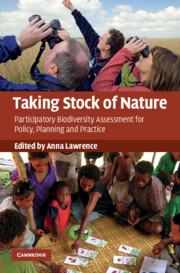Book contents
- Frontmatter
- Contents
- List of contributors
- Acknowledgements
- 1 Introduction: learning from experiences of participatory biodiversity assessment
- 2 Monitoring and assessment of biodiversity under the Convention on Biological Diversity and other international agreements
- 3 The Millennium Ecosystem Assessment: a multi-scale assessment for global stakeholders
- 4 Conservation of biological diversity in El Salvador shade coffee: the importance of taxonomic capacity for participatory assessments
- 5 Taking stock of nature in species-rich but economically poor areas: an emerging discipline of locally based monitoring
- 6 Researching local perspectives on biodiversity in tropical landscapes: lessons from ten case studies
- 7 Participatory resources monitoring in SW China: lessons after five years
- 8 Forest inventory in Nepal – technical power or social empowerment?
- 9 Perceptions of landscape change in British Columbia's Northwest: implications for biodiversity and participatory management
- 10 How thousands planned for a billion: lessons from India on decentralized, participatory planning
- 11 Inside monitoring: a comparison of bird monitoring groups in Slovenia and the United Kingdom
- 12 The personal and political of volunteers' data: towards a national biodiversity database for the UK
- 13 Improving forest management through participatory monitoring: a comparative case study of four community-based forestry organizations in the Western United States
- Index
- References
6 - Researching local perspectives on biodiversity in tropical landscapes: lessons from ten case studies
Published online by Cambridge University Press: 06 December 2010
- Frontmatter
- Contents
- List of contributors
- Acknowledgements
- 1 Introduction: learning from experiences of participatory biodiversity assessment
- 2 Monitoring and assessment of biodiversity under the Convention on Biological Diversity and other international agreements
- 3 The Millennium Ecosystem Assessment: a multi-scale assessment for global stakeholders
- 4 Conservation of biological diversity in El Salvador shade coffee: the importance of taxonomic capacity for participatory assessments
- 5 Taking stock of nature in species-rich but economically poor areas: an emerging discipline of locally based monitoring
- 6 Researching local perspectives on biodiversity in tropical landscapes: lessons from ten case studies
- 7 Participatory resources monitoring in SW China: lessons after five years
- 8 Forest inventory in Nepal – technical power or social empowerment?
- 9 Perceptions of landscape change in British Columbia's Northwest: implications for biodiversity and participatory management
- 10 How thousands planned for a billion: lessons from India on decentralized, participatory planning
- 11 Inside monitoring: a comparison of bird monitoring groups in Slovenia and the United Kingdom
- 12 The personal and political of volunteers' data: towards a national biodiversity database for the UK
- 13 Improving forest management through participatory monitoring: a comparative case study of four community-based forestry organizations in the Western United States
- Index
- References
Summary
CIFOR's Multidisciplinary Landscape Assessment approach
The Multidisciplinary Landscape Assessment (MLA) approach, initiated in 1999 by researchers at the Center for International Forestry Research (CIFOR) in collaboration with various partners, combines a technical survey of species, habitats and landscape locations with an assessment of their significance to local people. It fits the CIFOR mission to conduct research relevant to improving natural resource management and benefiting people. Its main claim to distinctiveness lies in its multi-disciplinary range of methods. The MLA landscape is defined by the people that live in it: how they define its land and vegetation types, the way they relate to it and use it: ‘a holistic and spatially explicit concept that is much more than the sum of its components: terrain, soil, land cover and use, […] a cultural construction’ (Sheil et al., 2003). The geographical scale of the landscape depends on the distances or (territories) that people cover to meet their livelihood needs. None of the studies explicitly explored local communities' concepts of ‘biodiversity’ and the term was never used with them. Rather the emphasis was on the environment and landscape in which people lived.
Since the first survey was conducted, others have used the approach in similar surveys. This chapter describes the basic methods; then compares the application and outcomes of the approach in ten case studies.
The basic approach
The approach and initial methods were developed during an extended two-month workshop and field trial in Malinau, East Kalimantan.
- Type
- Chapter
- Information
- Taking Stock of NatureParticipatory Biodiversity Assessment for Policy, Planning and Practice, pp. 113 - 141Publisher: Cambridge University PressPrint publication year: 2010
References
- 1
- Cited by



